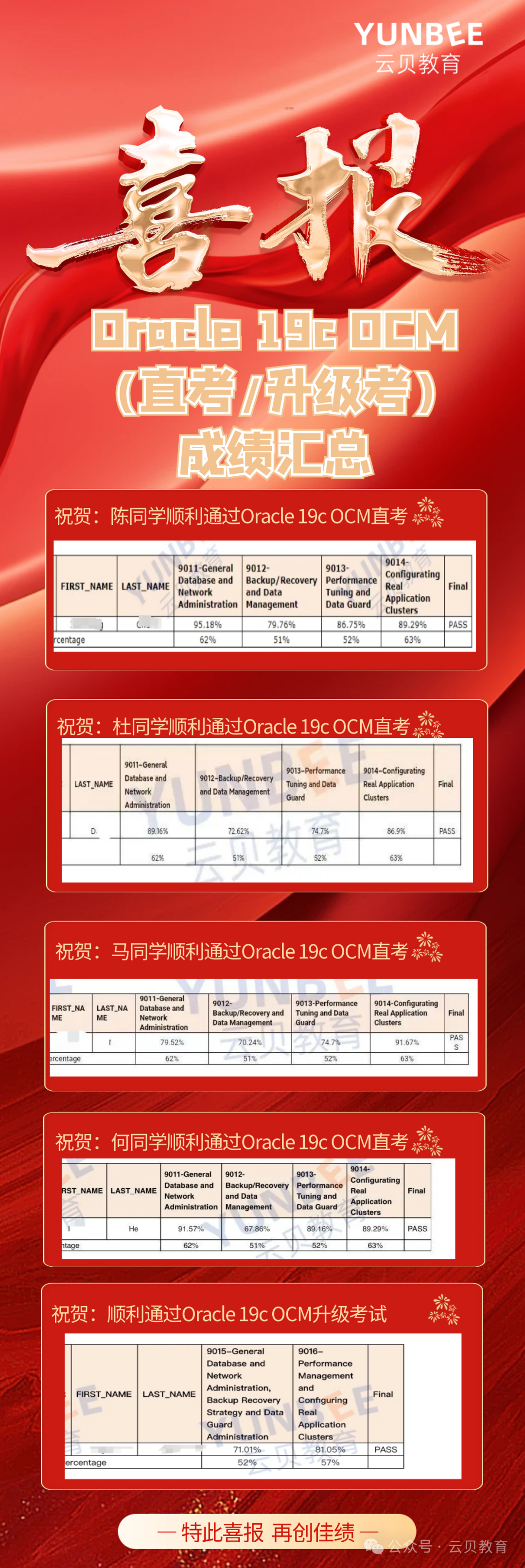
咨询Oracle 19c OCM考试详情请联系课程顾问

19c OCM技术培训的28天课程大纲
OCM最新一期开课时间:10.26(周末班)
11月30日之前报名的学员赠送一次价值¥15000的免费补考
课程 | 课程 | 时间/ 上课方式 |
01.Oracle Database 19c: Managing Multitenant Architecture | 01.CDB Basics 02.CDB and Regular PDBs 03.Application PDBs and Application Installation | 多租户 (4天/录播) |
04.PDB Creation 05.CDB and PDB Management 06.Storage | ||
07.Security 08.Backup and Duplicate 09.Recovery and Flashback 10.Performance 11.Resources Allocation | ||
12.Data Movement 13.Upgrade Methods 14.Miscellaneous 15.Processes, Views, Parameters, Packages, and Privileges 16.Consolidated Database Replay Procedures | ||
02.Oracle Database 19c: Performance Management and Tuning | 01.Overview 02.Defining the Scope of Performance Issues 03.Using the Time Model to Diagnose Performance Issues 04.Using Statistics and Wait Events to Diagnose Performance Issues 05.Using Log and Trace Files to Monitor Performance 06.Using Enterprise Manager Cloud Control and SQL Developer to Monitor Performance | DB Performance & SQL Tuning (6天/直播) |
07.Using Statspack to View Performance Data 08.Using Automatic Workload Repository 09.Using Metrics and Alerts 10.Using Baselines 11.Managing Automated Maintenance Tasks 12.Using ADDM to Analyze Performance 13.Using Active Session History Data for First Fault System Analysis 14.Using Emergency Monitoring and Real-Time ADDM to Analyze Performance Issues | ||
15.Overview of SQL Statement Processing 16.Maintaining Indexes 17.Maintaining Tables 18.Introduction to Query Optimizer 19.Understanding Execution Plans 20.Viewing Execution Plans by Using SQL Trace and TKPROF 21.Managing Optimizer Statistics 22.Using Automatic SQL Tuning 23.Using the SQL Plan Management Feature | ||
24.Overview of the SQL Advisors 25.Using the SQL Tuning Advisor 26.Using the SQL Access Advisor 27.Overview of Real Application Testing Components 28.Using SQL Performance Analyzer to Determine the Impact of Changes 29.Using Database Replay to Test System Performance | ||
30.Implementing Real-Time Database Operation Monitoring 31.Using Services to Monitor Applications 32.Overview of Memory Structures 33.Managing Shared Pool Performance 34.Managing Buffer Cache Performance 35.Managing PGA and Temporary Space Performance | ||
36.Configuring the Large Pool 37.Using Automatic Shared Memory Management 38.Introduction to In-Memory Column Store 39.Configuring the In-Memory Column Store Feature 40.Using the In-Memory Column Store Feature to Improve SQL Performance 41.Using In-Memory Column Store with Oracle Database Features | ||
03.Oracle Database 19c: Clusterware Administration Workshop | 01.Introduction to Clusterware 02.Accessing an Oracle Database 03.Cluster Configuration Options 04.Grid Infrastructure Preinstallation Tasks 05.Grid Infrastructure Installation 06.Managing Cluster Nodes | 高可用 (10天/直播) |
07.Traditional Clusterware Management 08.Policy-Based Cluster and Capacity Management 09.Upgrading and Patching Grid Infrastructure 10.Monitoring and Troubleshooting Oracle Clusterware 11.Making Applications Highly Available with Oracle Clusterware | ||
04.Oracle Database 19c: ASM Administration Workshop | 01.ASM Overview 02.Administering ASM Instances 03.Flex ASM 04.Administering ASM Disk Groups Part I 05.Administering ASM Disk Groups Part II 06.Flex ASM Disk Groups | |
07.Administering ASM Files, Directories, and Templates 08.Administering Oracle ACFS 09.ACFSADVM Enhancements 10.Oracle ASM Advanced Topics 11.Point-In-Time Database Clones | ||
05.Oracle Database 19c: RAC Administration Workshop | 01.Grid Infrastructure:Overview 02.RAC Databases Overview and Architecture 03.Installing with Configuring Oracle RAC 04.Oracle RAC Administration 05.Upgrading and Patching Oracle RAC | |
06.Managing Backup and Recovery for RAC 07.Global Resource Management Concepts. 08.RAC Database Monitoring and Tuning. 09.Managing High Availability of Services 10.High Availability for Connections and Applications | ||
11.Oracle RAC One Node 12.Oracle Database In-Memory in RAC 13.Multitenant Architecture and RAC 14.Quality of Service Management | ||
06.Oracle Database 19c: Data Guard Administration Workshop | 01.Introduction to Oracle Data Guard 02.Oracle Net Services in a Data Guard Environment 03.Creating a Physical Standby Database by Using SQL and RMAN Commands 04.Managing Physical Standby Files After Structural Changes on the Primary Database 05.Using Oracle Active Data Guard Supported Workloads in Read-Only Standby 06.Using Oracle Active Data Guard Far Sync and Real-Time Cascading | |
07.Creating and Managing a Snapshot Standby Database 08.Creating a Logical Standby Database 09.Oracle Data Guard Broker Overview 10.Creating a Data Guard Broker Configuration 11.Monitoring a Data Guard Broker Configuration 12.Configuring Data Protection Modes | ||
13.Optimizing and Tuning a Data Guard Configuration 14.Performing Role Transitions 15.Using Flashback Database in a Data Guard Configuration 16.Enabling Fast-Start Failover 17.Backup and Recovery Considerations in an Oracle Data Guard Configuration 18.Enhanced Client Connectivity in a Data Guard Environment 19.Patching and Upgrading Databases in a Data Guard Configuration | ||
07.Oracle Database 19c:Examination guidance | Module1:General database |
OCM认证 考试辅导 (7天/录播+ 1天/直播) |
Module1:.network administration | ||
Module2: Backup/Recovery | ||
Module2: Data Management | ||
Module3: Perormance management | ||
Module3: Configuring Data Guard | ||
Module4: 01.Configuring Real Application Clusters | ||
01.exercise 02.answer questions |






